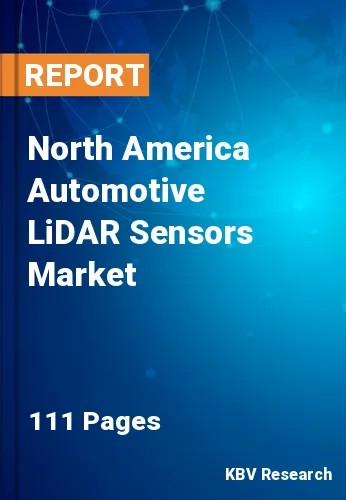
The North America Automotive LiDAR Sensors Market would witness market growth of 31.3% CAGR during the forecast period (2023-2029).
Demand for LiDAR technology is anticipated to soar in the future years as a result of the automotive industry's continuous efforts to develop autonomous and semi-autonomous vehicles. Self-driving cars may now acquire enough information about their surroundings due to LiDAR technology that the onboard computer can take over and take the driver's position. Automotive LiDAR sensor market participants are putting a lot of effort into the research and development of clever and distinctive business strategies to maintain their market leadership. Joint ventures and product development are some of these tactics.
Traditional methods of environmental detection can potentially result in inaccurate conditions assessments due to their inherent limitations. Within the context of the LiDAR system, this enables the creation of a 3D map of the surrounding area more expediently. It offers a reliable approach to land surveying. Through the use of Automotive LiDAR Sensors, it demonstrates an improved capability for automated processing. Data processing capabilities and image resolution are significantly more advanced than those of traditional approaches. These attributes give Automotive LiDAR Sensors a competitive advantage over its competitors. Thus, the advantages of LiDAR's innovative methods provided above the traditional ones are making a major market driver.
Mexico's road traffic fatalities have remained high in recent years, despite substantial efforts at national and subnational levels. This is noteworthy considering the country's population of almost 130 million. In the fiscal year of 2019, there were around 16,000 recorded fatalities. In addition, the lack of accountability among different sectors and institutions in Mexico has posed challenges for the federal government to accomplish intersectoral coordination and progress in road safety, leading to fatal and non-fatal traffic injuries. The increasing number of road accidents in the region presents a potential for growth in automotive LiDAR sensors as they can be implemented in vehicles with other safety systems to increase the vehicle's and passenger's overall safety, which will aid in greatly reducing accidents, leading to increased adoption and expansion of the market in North America.
The US market dominated the North America Automotive LiDAR Sensors Market by Country 2022, and would continue to be a dominant market till 2029; thereby, achieving a market value of $1,292.2 Million by 2029. The Canada market is poised to grow at a CAGR of 34.3% during (2023 - 2029). Additionally, The Mexico market would witness a CAGR of 33.2% during (2023 - 2029).
Based on Type, the market is segmented into Time of Flight (ToF), and Frequency-Modulated-Continuous-Wave (FMCW). Based on Technology, the market is segmented into Solid-state, and Electro-mechanical. Based on Vehicle Type, the market is segmented into Internal Combustion Engine (ICE), Hybrid, and Battery Electric. Based on Image Type, the market is segmented into 2 Dimensional, and 3 Dimensional. Based on Application, the market is segmented into Semi-autonomous Vehicles, and Autonomous Vehicles. Based on countries, the market is segmented into U.S., Mexico, Canada, and Rest of North America.
Free Valuable Insights: The Worldwide Automotive LiDAR Sensors Market is Projected to reach USD 5.3 Billion by 2029, at a CAGR of 32.1%
The market research report covers the analysis of key stake holders of the market. Key companies profiled in the report include Robert Bosch GmbH, Continental AG, Denso Corporation, Ouster, Inc., HELLA GmbH & Co. KGaA, First Sensor AG (TE Connectivity Ltd.), Texas Instruments, Inc., KUBOTA Corporation, Quanergy Systems, Inc. and LeddarTech Inc.
By Type
By Technology
By Vehicle Type
By Image Type
By Application
By Country
Our team of dedicated experts can provide you with attractive expansion opportunities for your business.
